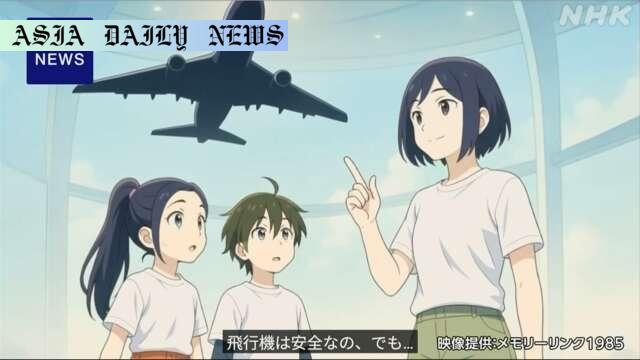JAL Crash Anime: A son’s heartfelt mission to preserve the memory of a devastating aviation tragedy using generative AI.
Son of 1985 JAL crash victim creates anime using AI to pass on memories of the tragedy.
The video conveys the story and lessons learned for future generations through expressive animation.
An effort to ensure younger audiences and international viewers understand key messages about aviation safety.

Preserving the Memory of Tragedy Through Anime
In a heartfelt tribute to the 1985 Japan Airlines crash, Yamamoto Masayoshi, son of a victim, has utilized modern technology to create an animated video ensuring the tragedy’s lessons live on. The crash, one of the deadliest in aviation history, claimed 520 lives, including his father Kenji. As the 40th anniversary approaches, Yamamoto sees the importance of passing on this somber chapter of history, particularly as the generation directly affected by the event ages.
The animation, lasting roughly one minute, employs generative artificial intelligence to narrate a poignant tale. It follows a woman who lost her parent in the crash, telling her children about the incident. Through vivid imagery and succinct narration, the video effectively captures the devastation of the crash site on Mount Takamagahara, the delayed rescue operations, and the ongoing pilgrimage of bereaved family members to honor the memories of lost loved ones. Yamamoto’s use of generative AI is instrumental in simplifying a complex historical event for universal understanding, making it accessible to both younger audiences and those unfamiliar with the tragedy.
Why Memory Matters: Beyond the 40-Year Mark
The project serves as a reminder of the importance of preserving historical accounts of tragedies. As generations pass, the vivid memories of such incidents risk fading into oblivion, yet the lessons learned remain critically relevant. Using storytelling in the form of animation bridges this gap, offering an emotive yet educative experience for viewers.
Furthermore, Yamamoto’s efforts reflect a universal human desire to find healing after loss and to ensure such events are not repeated. With innovations like AI-powered animation, stories gain new mediums of expression that transcend traditional platforms. It highlights how past tragedies can become valuable teaching tools in a time when awareness of history often seems diminished. Yamamoto’s video exemplifies these possibilities—encapsulating grief, memory, and hope in a manner that resonates universally.
Relevance of the JAL Tragedy in Today’s Context
At its core, the JAL 1985 tragedy teaches not just about aviation safety but also the collective responsibility of keeping individuals informed of the risks and preventive measures. Today’s world is equipped with advanced safety mechanisms and real-time technological interventions that might have avoided or mitigated similar disasters, but no system is entirely foolproof. Reflecting on historical failures, such as delayed rescue operations, ensures preparedness and underscores the need to improve adaptability in crisis scenarios.
Yamamoto’s video does more than tell a story—it calls for vigilance, empathy, and proactive measures to prevent accidents. By emphasizing the human cost of oversight in moments of crisis, he delivers a powerful reminder that the safety of passengers lies not just in hands of technology but also in human responsibility. The subtext of his work connects deeply to the larger global narrative of creating safer spaces in air travel today.
Conclusion
Through an innovative and heartfelt approach, Yamamoto Masayoshi transforms his personal tragedy into a timeless lesson for all. His AI-assisted project underlines the immense potential of technology in storytelling. By shedding light on forgotten histories, this initiative reaches beyond Japan’s borders, creating an impact with people of all ages across the globe. It also exemplifies how individuals, even those touched by tragedy, can become beacons of hope and education for others to follow.



Commentary
The Role of Technology in Retelling History
Yamamoto Masayoshi’s efforts to preserve and pass on the JAL crash tragedy using generative AI bring forth an inspiring example of technology’s role in storytelling and education. In an era where visual media dominates information dissemination, his approach effectively caters to younger audiences who may not engage with conventional history books or documentaries.
What makes his work especially profound is how it blends personal emotion with cutting-edge innovation. The use of an animated video resonates universally, cutting across cultural and generational barriers. It also demonstrates the accessibility of AI tools in empowering individuals to share personal histories in creative and impactful ways.
The Necessity of Preserving Lessons from the Past
As time passes, memories of catastrophic events become blurred, often leading to gaps in understanding the lessons they once offered. Yamamoto’s animated project highlights the need for vigilance and learning from history. The delayed rescue efforts during the 1985 crash underline the critical need for improvements in emergency response, a lesson as relevant today as it was four decades ago.
Additionally, it reflects a broader truth: that humanity honors its losses not merely by remembering them, but by actively learning from them. By creating educational content around such events, Yamamoto transforms a personal tragedy into a universally instructive narrative, ensuring that the sacrifice of those who lost their lives is not forgotten.
A Vision for the Future Using History
In broader terms, Yamamoto’s AI-powered project serves as a touchstone for how tragedies can shape the future. It isn’t merely about recounting what happened but is, more importantly, about enacting meaningful change inspired by the past. The younger generation, through such mediums, can internalize the importance of proactive safety measures, empathy, and collective responsibility in preventing such events.
His work is a poignant reminder of how technology, when combined with personal resolve, creates ripples of awareness that extend beyond borders or timelines. This blend of innovation and emotion ensures that a painful chapter of history evolves into a lasting legacy of safety, compassion, and preparedness.